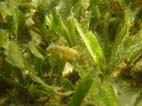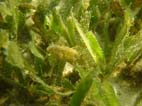

As a sub-component of Reversing Environmental Degradation Trends in the South China Sea and Gulf of Thailand, a project commissioned by the UNEP and Global Environmental Facility (GEF), CAS researchers have been conducting fruitful research on seagrass in the coastal areas of south China.
Started from January 2002, a research team, headed by Prof. Huang Xiaoping with the CAS South China Institute of Oceanography, has made efforts to map and study seagrass meadows in the coastal areas in Guangdong, Hainan provinces and Guangxi Zhuang Autonomous Region. The $280,000 investigation has led to the discovery of seagrass beds with a total area of more than 2,000 hectares in the coastal area of south China. Via the survey, the scientists have initially made clear the geographic distribution of seagrass, its taxonomic composition, coverage, productivity, and the bio-diversity and ecological features of the seagrass ecosystem.
As one of the three typical ecosystems in shallow seas (the other two are mangrove and coral reef), the seagrass forms the groundwork for many complex marine ecosystems and provide a valuable nursery for commercially important fish and crustaceans. When the seagrass decline, the links in the productivity chain are broken and the whole ecosystem collapses. Most importantly, it has ecological value in purification of water quality, absorption of the excessive nutrients which tend to trigger the outbreak of "red tides", that is algal blooms, silt fixation and acts as a spawning field for various marine organisms. In addition, the seagrass beds are ideal habitats and shelters for sea turtles, Dugong and other rare kinds of wildlife.
Of the 50 or so species of seagrass in the world, the South Sea is home to a dozen. Before this investigation, the topic had hardly been touched in this country and its importance in the development of the marine ecosystems was undervalued.
The researchers found the current state of the seagrass is far from being satisfactory. Taking the Liusha Bay as an example, the 800-900-hectare underwater pastureland used to be a living paradise for starfish, Holothurian, shrimp, mollusc, sea urchin and other living beings on a sea coast, the inappropriate fishing methods by the local people and their activities to collect spiral shells after the ebb tide have caused serious devastation on the native seagrass resources.
To turn the unsatisfactory state for better, the research group is working on suggestions for national legislation and action plans for the preservation of seagrass areas, the selection of its protection areas and the implementation of proper management.






